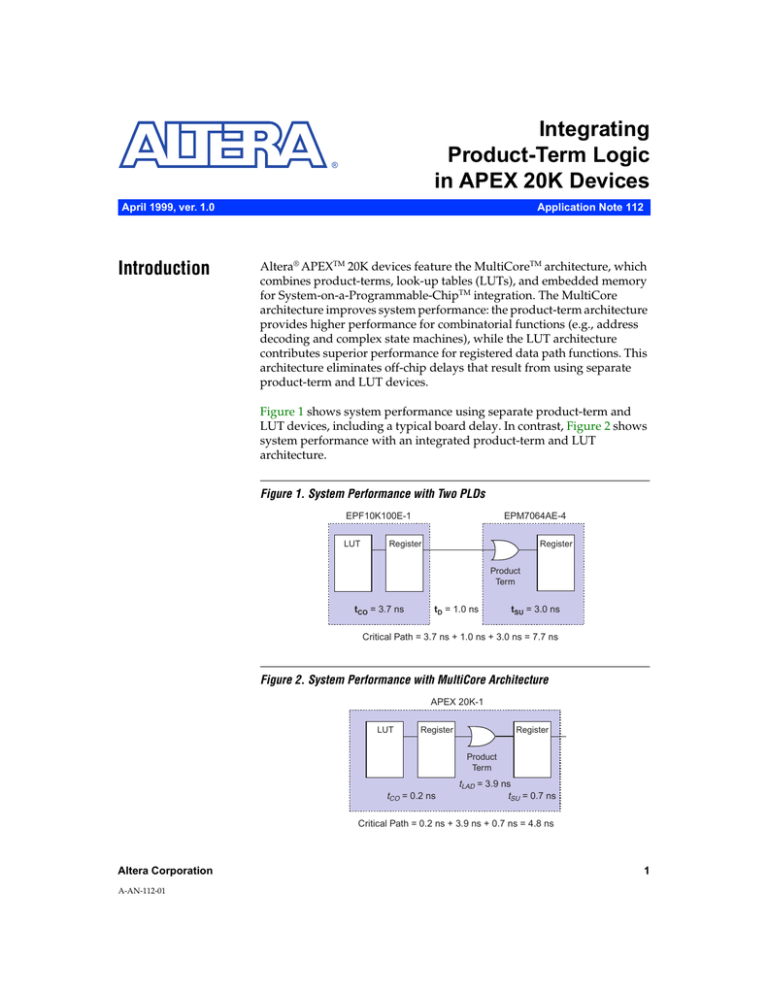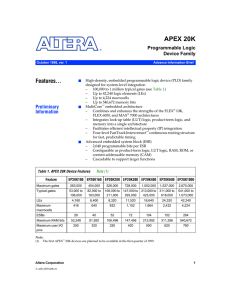
Integrating
Product-Term Logic
in APEX 20K Devices
®
April 1999, ver. 1.0
Introduction
Application Note 112
Altera® APEXTM 20K devices feature the MultiCoreTM architecture, which
combines product-terms, look-up tables (LUTs), and embedded memory
for System-on-a-Programmable-ChipTM integration. The MultiCore
architecture improves system performance: the product-term architecture
provides higher performance for combinatorial functions (e.g., address
decoding and complex state machines), while the LUT architecture
contributes superior performance for registered data path functions. This
architecture eliminates off-chip delays that result from using separate
product-term and LUT devices.
Figure 1 shows system performance using separate product-term and
LUT devices, including a typical board delay. In contrast, Figure 2 shows
system performance with an integrated product-term and LUT
architecture.
Figure 1. System Performance with Two PLDs
EPF10K100E-1
LUT
EPM7064AE-4
Register
Register
Product
Term
tCO = 3.7 ns
tD = 1.0 ns
tSU = 3.0 ns
Critical Path = 3.7 ns + 1.0 ns + 3.0 ns = 7.7 ns
Figure 2. System Performance with MultiCore Architecture
APEX 20K-1
LUT
Register
Register
Product
Term
tCO = 0.2 ns
tLAD = 3.9 ns
tSU = 0.7 ns
Critical Path = 0.2 ns + 3.9 ns + 0.7 ns = 4.8 ns
Altera Corporation
A-AN-112-01
1
AN 112: Integrating Product-Term Logic in APEX 20K Devices
f
For more information on APEX 20K devices, see the APEX 20K
Programmable Logic Device Family Data Sheet.
This application note describes the APEX 20K architecture and explains
how to implement product-term logic.
MegaLAB
Structure
The basic building block of the APEX 20K family is the MegaLABTM
structure, which contains 16 logic array blocks (LABs), each comprised of
10 logic elements (LEs); these LEs are architecturally equivalent to
FLEX® 6000 LEs. Each APEX MegaLAB structure also has an embedded
system block (ESB) that is configurable as 2,048-bit dual-port RAM, ROM,
or content-addressable memory (CAM), or as 16 product-term macrocells.
Each macrocell contains two product terms that can be combined through
an OR gate or an XOR gate, and a programmable inverter for wide-input OR
functions. The output of each macrocell can be registered with each
register containing a clock enable and an asynchronous clear. The register
can also emulate an asynchronous preset by using the NOT-Gate PushBack option in the QuartusTM software. Additionally, the ESB macrocell
includes parallel expanders that can feed or be fed by an adjacent
macrocell. Parallel expanders improve system performance and
routability, making the ESB product-term architecture ideal for
applications that require wide multiplexing and high fan-in. Figure 3
shows the MegaLAB structure.
Figure 3. MegaLAB Structure
MegaLAB Interconnect
To Adjacent
LAB or IOEs
LE1
LE2
LE3
LE4
LE5
LE6
LE7
LE8
LE9
LE10
Local
Interconnect
2
LE1
LE2
LE3
LE4
LE5
LE6
LE7
LE8
LE9
LE10
LE1
LE2
LE3
LE4
LE5
LE6
LE7
LE8
LE9
LE10
LABs
ESB
ESB Implements
Product-Term Logic
Altera Corporation
AN 112: Integrating Product-Term Logic in APEX 20K Devices
Product-Term Logic in the ESB
The product-term portion of the MultiCore architecture is implemented
with the ESB. An ESB can be configured to act as a block of macrocells on
an ESB-by-ESB basis. Each ESB is fed by 32 inputs from the adjacent local
interconnect; therefore, it can be driven by the MegaLAB interconnect or
the adjacent LAB. Also, 9 ESB macrocells feed back into the ESB through
the local interconnect for higher performance. Dedicated clock pins,
global signals, and additional inputs from the local interconnect drive the
ESB control signals.
In product-term mode, each ESB contains 16 macrocells. Each macrocell
consists of two product terms and a programmable register. The
programmable register can implement D, T, JK, or SR flipflops. Parallel
expanders make the ESB product-term configuration ideal for
applications requiring wide multiplexing and high fan-in. Figure 4 shows
the APEX ESB macrocell.
Figure 4. APEX ESB Macrocell
Parallel Expander Out
D
Q
ENA
CLRN
Parallel Expander In
Parallel expanders make the ESB product-term configuration ideal for
applications requiring wide multiplexing and high fan-in because they
can be used to drive up to 32 product terms to a single macrocell. Figures 5
and 6 show the APEX ESB parallel expanders and feedback, respectively.
Altera Corporation
3
AN 112: Integrating Product-Term Logic in APEX 20K Devices
Figure 5. APEX ESB Parallel Expanders
Parallel Expanders
ESB
MC1
MC2
MC3
32
MC16
Local Interconnect
4
ESB Implementing Product-Term Logic
Altera Corporation
AN 112: Integrating Product-Term Logic in APEX 20K Devices
Figure 6. APEX ESB Feedback
Macrocells 1-9 Feedback
via the Local Interconnect
9
ESB
MC1
MC2
MC3
32
MC9
MC16
Local Interconnect
Altera Corporation
ESB Implementing Product-Term Logic
5
AN 112: Integrating Product-Term Logic in APEX 20K Devices
Improving
Performance by
Using
Product Terms
The MultiCore architecture improves system performance: the productterm architecture provides higher performance for combinatorial
functions such as address decoding and state machines, while the LUT
architecture contributes superior performance for registered data path
functions. Subdesigns such as wide-input functions and state machines
are implemented more efficiently in product terms; therefore, combining
two architectures in one device results in better performance and device
utilization.
Table 1 compares performance and device utilization for common
applications implemented in product-term and LUT-based architectures.
Thirty-two product terms require the same silicon area as 50 LEs. The
wide-input AND gate and state machine are faster and implemented more
efficiently in the product-term architecture, while the multiplier and
multiplexer are better implemented in the LUT.
The product-term delay of the APEX ESB is approximately 3.9 ns; the
parallel expander delays of the ESB are approximately 0.7 ns.
6
Altera Corporation
AN 112: Integrating Product-Term Logic in APEX 20K Devices
Table 1. APEX Performance & Utilization for Common Applications
Function
Product Terms
LUTs
Utilization
Performance
(MHz)
32-bit AND gate
with registered
inputs and
outputs
192
1 product
term (die size
equivalent to
1.6 LEs) (1)
172
8 LEs (1)
v
192
8-state, 6-input/
11-output
148-transition
state machine
76
204 product
terms
(die size
equivalent to
319 LEs)
66
366 LEs
v
76
149
20 product
terms
(die size
equivalent to
30 LEs) (1)
185
10 LEs (1)
v
185
52
702 product
terms
(die size
equivalent to
1,097 LEs)
188
135 LEs (1)
v
188
8 × 8 registered
I/O multiplier
Product
Term
LUT
APEX
Performance
(MHz)
Performance
(MHz)
16-to-1 registered
I/O multiplexer
Utilization
Ideal Solution
(1)
Note:
(1)
Input registers are not included in utilization numbers.
Register Placement for Optimal Performance
For optimal performance in product-term mode, registers that are used to
drive product terms can be placed in the LAB that is adjacent to the ESB.
This LAB directly drives the local interconnect that drives the ESB,
eliminating any routing delays through the MegaLAB interconnect.
Timing-driven compilation in the Quartus software will also use this
placement to meet user-specified timing requirements. See Figure 7.
Altera Corporation
7
AN 112: Integrating Product-Term Logic in APEX 20K Devices
Figure 7. Optimal Placement of Logic
MegaLAB Interconnect
LE1
LE2
LE3
LE4
LE5
LE6
LE7
LE8
LE9
LE10
LE1
LE2
LE3
LE4
LE5
LE6
LE7
LE8
LE9
LE10
LUT
ESB
Register
Product
Terms
Register
Adjacent Local
Interconnect
Using Turbo Mode
The APEX ESB has a “turbo” mode that improves performance of logic
implemented in the ESB. The Quartus software provides designers with
the option to turn on this feature for improved performance or turn off
this feature for reduced power consumption. Using the Quartus software,
you can implement this APEX ESB feature on an ESB-by-ESB basis.
Using Quartus Software to Implement Product-Term Logic
Altera’s Quartus software, which supports APEX 20K devices, allows you
to control APEX ESB implementation in product-term mode on either
specific blocks of logic or on an ESB-by-ESB basis. You can implement
product-term, LUT, and ROM configurations of the ESB using the
Assignment Organizer dialog box (see Figure 11 on page 11). RAM,
ROM, and CAM logic designs are implemented through megafunctions.
8
Altera Corporation
AN 112: Integrating Product-Term Logic in APEX 20K Devices
The Quartus software supports multiple methods for implementing logic
in product-term mode. For example, logic can be targeted for productterm mode on a hierarchical level. If you target a hierarchy level for
product-term mode, that hierarchy level and all of its lower levels will be
implemented using the product-term mode configuration. By using the
Quartus software, you can also target a hierarchy level as AUTO. Based on an
area utilization algorithm, the Quartus software automatically decides if
the logic is better implemented in product terms or LUTs. A lower
hierarchy level may be targeted for a different logic implementation than
its parent hierarchy level (only if the targeted higher level is set for LUT or
AUTO).
Figure 8 demonstrates hierarchical implementation capability of logic in
product-term mode using the Quartus software.
Figure 8. Hierarchical Implementation
Top-Level Hierarchical Design
AUTO
Assignment
Product-Term
Assignment
AUTO
AUTO
AUTO
AUTO
Product
Term
LUT
Assignment
LUT
Product Term
AUTO
Product
Term
LUT
LUT
LUT
Product-Term
Assignment
Logic can be targeted globally or on an entity-by-entity basis. You can
target an entity for product-term implementation. If other instances of the
entity occur within the design, the Quartus software also provides the
option to have the other instances implemented in product-term mode.
Figure 9 demonstrates the entity-based implementation capability of logic
in product-term mode using the Quartus software.
Altera Corporation
9
AN 112: Integrating Product-Term Logic in APEX 20K Devices
Figure 9. Entity-Based Implementation
Top-Level Hierarchical Design
Entity
Entity
Entity
Product-Term
Assignment
Other instantiations of the same entity are also implemented in product-term mode.
Entity
Using the Quartus software, perform the following steps to designate a
hierarchy level for product-term mode.
1.
Open the Project Navigator in the Quartus software.
2.
Right-click on the desired hierarchy level and choose Assignments.
See Figure 10.
Figure 10. Targeting Logic for Product-Term Mode
10
Altera Corporation
AN 112: Integrating Product-Term Logic in APEX 20K Devices
3.
Open the list of files under Options for Entities Only and select the
Technology Mapper assignment category in the Assignment
Organizer dialog box. This selection maps logic to a specified mode
(see Figure 11).
4.
Choose Pterm in the Setting drop-down list box and click Add/Change.
5.
Click Apply to continue to adjust assignments or click OK if you are
finished.
Figure 11. Assignment Organizer Dialog Box
Altera Corporation
11
AN 112: Integrating Product-Term Logic in APEX 20K Devices
Third-Party Software Support
The Quartus software supports product-term logic designs created in
Exemplar Logic, Synopsys, Synplicity, and Viewlogic synthesis tools. The
Quartus software features a true WYSIWYG (What-You-See-Is-WhatYou-Get) option that allows third-party tools to synthesize product-term
logic in the APEX ESB architecture. Logic blocks pass through the Quartus
Compiler without further synthesis, ensuring optimal design
implementation. The WYSIWYG product-term structure can be passed
from third-party tools to the Quartus software through Verilog HDL,
EDIF, and VHDL files. In addition to ESB product-term mode, you can
access LUT logic, ESB RAM, or ROM storage through third-party tools.
Conclusion
Altera’s APEX 20K devices feature the MultiCore architecture, which
combines product-term, LUT, and embedded memory architectures. By
using the MultiCore architecture, you can integrate your design into one
device, improving system performance.
f
For more information on APEX 20K devices and the Quartus software, see
the APEX 20K Programmable Logic Device Data Sheet and the Quartus
Programmable Logic Development System & Software Data Sheet.
®
101 Innovation Drive
San Jose, CA 95134
(408) 544-7000
http://www.altera.com
Applications Hotline:
(800) 800-EPLD
Customer Marketing:
(408) 544-7104
Literature Services:
(888) 3-ALTERA
lit_req@altera.com
12
Altera, APEX, APEX 20K, EPF10K100E, EPM7064S, FLEX, FLEX 6000, MegaLAB, MultiCore, Quartus, and
System-on-a-Programmable-Chip are trademarks and/or service marks of Altera Corporation in the United
States and other countries. Altera acknowledges the trademarks of other organizations for their respective
products or services mentioned in this document. Altera products are protected under numerous U.S. and
foreign patents and pending applications, maskwork rights, and copyrights. Altera warrants performance of
its semiconductor products to current specifications in accordance with Altera’s standard warranty, but
reserves the right to make changes to any products and services at any time without notice. Altera assumes no
responsibility or liability arising out of the application or use of any information, product, or
service described herein except as expressly agreed to in writing by Altera Corporation.
Altera customers are advised to obtain the latest version of device specifications before
relying on any published information and before placing orders for products or services.
Copyright 1999 Altera Corporation. All rights reserved.
Altera Corporation
Printed on Recycled Paper.




